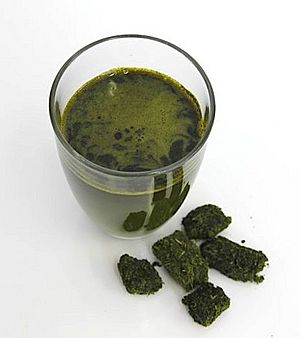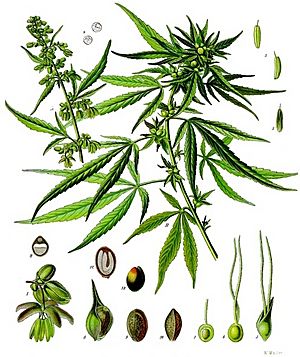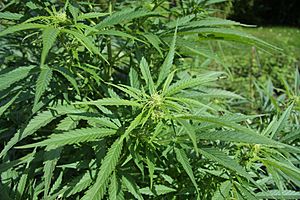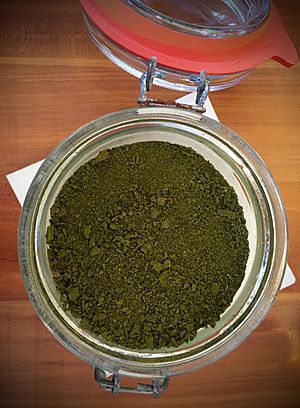Hemp juice facts for kids
Hemp juice is a drink made from the Cannabis sativa plant, specifically from a type called industrial hemp. It's made by pressing the upper parts and leaves of the hemp plant using a special method called cold-pressing. This is different from other hemp products like hemp oil or hemp milk, which are usually made from the seeds.
Many people believe hemp juice can be used in healthy foods, medicines, beauty products, and drinks. It's also known for its umami flavor, which makes other foods taste better. Because it has a lot of protein, hemp juice is also seen as a healthy food.
Scientists are studying the possible health benefits of a natural compound in industrial hemp and hemp juice called CBD. Industrial hemp is special because it has very low levels of tetrahydrocannabinol (THC). This low THC content means industrial hemp and its juice are legal to grow and use in many countries.
People have found many ways to use hemp juice. For example, the leftover plant material from making the juice can be mixed into bread dough. You can also find hemp juice as a food supplement in a powder form, especially because it's rich in protein.
Supporters of hemp products say that hemp is a sustainable food source. This means it's good for the environment because it doesn't need as much water or special care as some other crops.
Contents
What is Industrial Hemp?
Hemp juice is made from industrial hemp that is harvested before its seeds are fully grown. This juice is a type of liquid mixture called an emulsion. At the best time to harvest industrial hemp, the green plant contains special omega oils, many natural compounds called cannabinoids, and other good ingredients.
In Europe, industrial hemp is any hemp plant with less than 0.2% THC. In the US and Canada, it's less than 0.3% THC. Because of these low THC levels, industrial hemp is considered a drug-free food. This makes it legal to sell and use in many places without the strict rules that apply to other cannabis products with higher THC.
What's Inside Hemp Juice?
Natural Goodness
Drug-free hemp juice contains all the natural ingredients of the hemp plant. The highest amounts of natural compounds called cannabinoids and proteins are found in the hemp plant before its seeds are fully grown, when the plant is still green.
Besides healthy omega-n-fatty acids, hemp juice has over 100 different cannabinoids. These cannabinoids are special because they can connect with certain parts of the human body, like a system called the endocannabinoid system. Hemp is the only plant that naturally produces these cannabinoids.
Hemp juice also has many proteins that are easy for your body to digest. This includes all eight essential amino acids that humans need. Plus, the juice contains various minerals, vitamins, and many polyphenols, which are good for your health.
Taste and Color
The juice from the top parts of the hemp plant is a bright green color. By itself, it has a strong, bitter, "hempy" taste. But the juice from the plant's fibers and inner woody parts is lighter in color and tastes sweet. Hemp juice creates a special umami flavor. This comes from the many proteins, polyphenols, and cannabinoids in the plant. When you mix the bitter hemp juice with fruit or vegetable juices, it becomes fresh and sweet. It can even make the original taste of fruits and vegetables stand out more.
How Hemp Juice is Made
Harvesting and Pressing
Hemp juice is made using a special industrial method right after the hemp is harvested. The leafy top parts of the plant, including the flower heads, are cold-pressed. Before this method, these parts of the plant were often not used in making industrial hemp fabric. Now, pressing them for juice means a valuable part of the plant can be used for people to eat or drink. This process keeps all the good ingredients fresh without needing to dry the hemp. Making juice also doesn't stop farmers from producing fibers, so they can earn money from both.
On average, one hectare (about 2.5 acres) of hemp can produce around 3 tons of hemp juice. This new way of making juice helps farmers earn more money and makes growing industrial hemp more environmentally friendly. The cold-pressing method also keeps all the plant's natural ingredients active.
There are two main ways to harvest the plant for juice: "cutting" the top parts or "stripping" the leaves. Each method can lead to different amounts of cannabinoids in the juice, so the way it's harvested affects the juice's quality.
If only the leafy top part is used for juice, the rest of the hemp plant can still be used to make fibers or for other industrial purposes. This means making juice adds extra money for farmers without harming fiber production. In places where hemp seeds don't ripen easily, like Northern Europe, making juice is another great way to use the hemp plant.
After pressing the juice, about 3 tons of leftover plant material (press remnants) are also produced per hectare. About a quarter to a third of the good ingredients found in the juice are still in these remnants. These leftovers can be used as valuable food for people, for example, to bake bread. They can also be dried or fermented and used as animal feed.
Juice Amount
The amount of juice a hemp plant gives depends on how old it is. Younger plants usually have more juice than older ones. The plant gives the least juice after its seeds are fully grown because the leaves start to decay then. The type of press used also changes how much juice you get. On average, about 50% of the plant's weight turns into juice.
The top part of the plant has a lot of dry material, while the leaves have the least when the seeds are ripe. This high amount of dry material means the juice is rich in things like carbohydrates, amino acids, protein, fats, and other good substances.
Partial Harvest
In places with the right climate, farmers can harvest leaves for hemp juice and also get hemp seeds from the same field. This starts a few weeks after planting, by just harvesting the leafy tops. The plant then grows new tops, often many of them, which can be harvested later. If the plant keeps growing until the seeds are ripe, then hemp seeds can also be harvested. This means you can get both juice and seeds from one crop, and partial harvesting can even help produce more seeds.
Keeping Juice Fresh
One common way to keep hemp juice fresh for a long time is to freeze it right after it's cold-pressed. Freezing it quickly helps keep its quality. Once frozen, the juice can be freeze-dried into a powder that can be stored easily. Freezing and freeze-drying also help keep the natural form of the cannabinoids. Another way to preserve it is pasteurization, which uses heat to "activate" the cannabinoids. You can also make hemp juice last longer by fermentation, often by adding yeast and sugar. Adding salt to fresh hemp juice can also create a "hemp salt" product, which helps preserve it.
How Hemp Juice is Used
Hemp juice can be drunk, but it's quite bitter on its own. The bitterness goes away when you mix it with fruit or vegetable juices. Hemp juice can also make the fruity, savory, and sweet tastes of other juices and foods stronger. Because of this, hemp juice is often used in drinks, certain foods, seasonings, food supplements, and beauty products. The leftover plant material can also be used as food supplements.
Different from Other Hemp Liquids
Hemp juice is different from other liquid hemp products. For example, Hemp milk and hemp oil are made from the seeds of the plant, similar to how soy milk is made from soybeans. Drinks like hemp beer often use dried flowers or leaves. When dried hemp parts are soaked in water, the liquid extract only contains about 10% of the ingredients found in cold-pressed juice. This means cold-pressed hemp juice has many more important ingredients. Also, water extracts don't contain the important cannabinoids because these compounds stick to the plant's fatty acids, which don't dissolve in water. Cold-pressed hemp juice, however, does contain these valuable cannabinoids.
You can also make hemp juice at home with a regular blender. However, this isn't ideal for industrial hemp because its fibers are too tough for people to digest.
Drinks
Hemp juice can be used to make non-alcoholic drinks or as a base for alcoholic ones. It's often used in relaxing soft drinks because it can have a calming effect. Here are some ways it's used in drinks:
- As a mix for iced tea.
- As a fermented drink without alcohol (mixed with vegetable or fruit juice).
- Added to vegetable or fruit juices to make them sweeter, add more nutrients, and create an umami taste.
- To make light or dark non-alcoholic hemp drinks, similar to beer.
- As a base for strong alcoholic drinks, like hemp spirits.
- In herbal liqueurs or bitters, made with alcohol and sugar.
- As a mixer for alcoholic drinks like cocktails.
- As an ingredient for brewing hemp beer.
- As a base for gluten-free beer.
Gluten-free hemp beer doesn't need malt or cereal grains and is low in calories. Hemp is related to hops, which are used in beer, so it can give beer a nice bitter taste even without hops.
Seasoning
Even though hemp juice itself doesn't have a strong taste, its ability to make other flavors stronger makes it useful as a seasoning. Using hemp juice can help reduce the amount of salt and sugar needed in foods without losing flavor.
- Hemp Microgreens Powder works well as a seasoning on salads, in smoothies, or mixed into water.
- Hemp salt: This is made by mixing hemp juice with good quality table salt and drying it. It can be used in both cooked and uncooked dishes.
- Hemp sugar or hemp syrup: Hemp juice can help you use less sugar when combined with fruit juices, sweet dishes, or sugar, because it makes sweet flavors much stronger.
- Hemp juice's umami flavor makes the savory taste of any dish better. It's great for mixing, cooking, baking, ready meals, drinks, seasonings, pastries, jams, and soups.
Food Supplements
The valuable cannabinoids, proteins, vitamins, minerals, polyphenols, and healthy fats in hemp juice are good for preventing nutrient shortages and helping muscles grow. For example, athletes sometimes use protein powder made from hemp. Hemp juice offers a natural choice instead of industrially made hemp protein. Even the dietary fibers in the leftover plant material can be used as food supplements if they are fermented. Finely ground hemp leftovers can also replace some of the flour in bread recipes that use yeast.
Medicine and Cosmetics
Hemp has been used in traditional medicine for hundreds of years. Hemp juice can be added to creams and gels, and it has been used to help with skin conditions like eczema.
Because it has a lot of polyphenols, vitamins, and proteins, the juice can also be used in skin creams. Hemp salt, when added to a bath, can have a soothing effect on skin issues like neurodermatitis. Hemp juice is now appearing as an ingredient in many beauty products.
See also
 In Spanish: Jugo de cáñamo para niños
In Spanish: Jugo de cáñamo para niños





